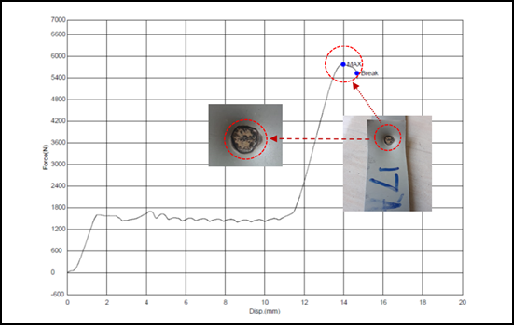Main Article Content
Abstract
The present study features analytical and experimental results of optimizing resistance spot welding performed using a pneumatic force system (PFS). The optimization was performed to join SECC-AF (JIS G 3313) galvanized steel material with SPCC-SD low carbon steel. The SECC-AF is an SPCC-SD (JIS G 3141) sheet plate coated with zinc (Zn) with a thickness of about 2.5 microns. The zinc coating on the metal surface causes its weldability to decrease. This study aims to obtain the highest tensile-shear strength test results from the combination of the specified resistance spot welding parameters. The research method used the Taguchi method using four variables and a combination of experimental levels. The experimental levels are 2-levels for the first parameter and 3-levels for other parameters. The Taguchi optimization experimental results achieved the highest tensile-shear strength at 5049.64 N. It properly worked at 22 squeeze time cycles, 25 kA of welding current, and 0.6-second welding time and 12 holding-time cycles. The S/N ratio analysis found that the welding current had the most significant effect, followed by welding time, squeeze time, and holding time. The delta S/N ratio values were 1.05, 0.67, 0.57 and 0.29, respectively.
Keywords
Article Details

This work is licensed under a Creative Commons Attribution-NonCommercial 4.0 International License.
References
- BSN, Galvanisasi (hot dip galvanized) pada besi dan baja fabrikasi - Spesifikasi dan metode pengujian. Indonesia, 2004.
- K. Wibisono, “Pabrik baja galvanis KNSS pertama di Indonesia selesai 60 persen,” AntaraNews, Jakarta, Mar-2016.
- R. Mazumdar, “Government may force automakers to use 70 per cent galvanised steel in car body,” The Economic Times, Aug-2018.
- M. P. Mubiayi, E. T. Akinlabi, and M. E. Makhatha, Current Trends in Friction Stir Welding (FSW) and Friction Stir Spot Welding (FSSW), vol. 6. 2019.
- J. Pan and K. Sripichai, “Mechanics modeling of spot welds under general loading conditions and applications to fatigue life predictions,” Woodhead Publishing Limited, 2010.
- A. H. Ertas and F. O. Sonmez, “Design optimization of spot-welded plates for maximum fatigue life,” Finite Elements in Analysis and Design, vol. 47, no. 4, pp. 413–423, 2011.
- D. Ren, D. Zhao, L. Liu, and K. Zhao, “Clinch-resistance spot welding of galvanized mild steel to 5083 Al alloy,” The International Journal of Advanced Manufacturing Technology, vol. 101, no. 1–4, pp. 511–521, 2019.
- Y. G. Kim, D. C. Kim, and S. M. Joo, “Evaluation of tensile shear strength for dissimilar spot welds of Al-Si-Mg aluminum alloy and galvanized steel by delta-spot welding process,” Journal of Mechanical Science and Technology, vol. 33, no. 11, pp. 5399–5405, 2019.
- S. H. M. Anijdan, M. Sabzi, M. Ghobeiti-hasab, and A. Roshan-ghiyas, “Optimization of spot welding process parameters in dissimilar joint of dual phase steel DP600 and AISI 304 stainless steel to achieve the highest level of shear-tensile strength,” Materials Science & Engineering A, vol. 726, no. April, pp. 120–125, 2018.
- D. L. Olson, S. Thomas A., S. Liu, Edwards, and R. A Glen, ASM Vol 6 Welding, Brazing, And Soldering, vol. 165. 2019.
- Miller Handbook, Handbook for Resistance Spot Welding. Miller Electric Mfg. Co., 2010.
- E. Gunawan, Sukarman, A. D. Shieddieque, C. Anwar, and Jatira, “Optimasi Parameter Proses Resistance Spot Welding pada Pengabungan Material SECC-AF,” in Seminar Nasional Teknologi dan Riset Terapan, 2019, no. September, pp. 132–137.
- P. S. Wei and T. H. Wu, “Electrode geometry effects on microstructure determined by heat transfer and solidification rate during resistance spot welding,” International Journal of Heat and Mass Transfer, vol. 79, pp. 408–416, 2014.
- H. Wiryosumarto and T. Okumura, Teknologi Pengelasan Logam, 8th ed. Jakarta: PT Pradnya Paramita, 2000.
- J. P. Oliveira, K. Ponder, E. Brizes, T. Abke, A. J. Ramirez, and P. Edwards, “Combining resistance spot welding and friction element welding for dissimilar joining of aluminum to high strength steels,” Journal of Materials Processing Technology, vol. 273, no. January, p. 116192, 2019.
- K. Vignesh, A. E. Perumal, and P. Velmurugan, “Optimization of resistance spot welding process parameters and microstructural examination for dissimilar welding of AISI 316L austenitic stainless steel and 2205 duplex stainless steel,” The International Journal of Advanced Manufacturing Technology, vol. 93, pp. 455–465, 2017.
- M. Tumuluru, Resistance spot weld performance and weld failure modes for dual phase and TRIP steels. Woodhead Publishing Limited, 2010.
- P. Muthu, “Optimization of the Process Parameters of Resistance Spot Welding of AISI 316l Sheets Using Taguchi Method,” Mechanics and Mechanical Engineering, vol. 23, no. 1, pp. 64–69, 2019.
- H. E. Emre and R. Kaçar, “Development of weld lobe for resistance spot-welded TRIP800 steel and evaluation of fracture mode of its weldment,” International Journal of Advanced Manufacturing Technology, Springer, vol. 85, pp. 1737–1747, 2016.
- A. G. Thakur and V. M. Nandedkar, “Optimization of the Resistance Spot Welding Process of Galvanized Steel Sheet Using the Taguchi Method,” Arabian Journal for Science and Engineering, vol.39, pp. 1171–1176, 2014.
- S. Shafee, B. B. Naik, and K. Sammaiah, “Resistance Spot Weld Quality Characteristics Improvement By Taguchi Method,” Materials Today: Proceedings, vol. 2, no. 4–5, pp. 2595–2604, 2015.
- W. Stichel, Handbook of comparitative world steel standards; USA-United Kingdom-Germany-France-Russia-Japan-Canada-Australia-International. Hrsg.: Albert & Melilli, 552 Seiten. ASTM Data Series DS 67, American Society for Testing and Materials, PA, USA 1996, £ 195.00, vol. 48, no. 6. 1997.
- Japanese Standards Association, JIS G 3313 Electrolytic zinc-coated steel sheet and coils. 1998, pp. 428–480.
- Japanese Standards Association, JIS G 3141 Cold-reduced carbon steel sheets and strip. 2005.
- ASTM International, ASTM D1002 Standard Test Method for Apparent Shear Strength of Single-Lap-Joint Adhesively Bonded Metal Specimens by Tension Loading (Metal-to-Metal). 2019.
- P. J. Ross, Taguchi Techniques for Quality Engineering. New York: Tata McGraw-Hill, 2005.
- A. Abdulah, S. Sukarman, C. Anwar, A. Djafar Shieddieque, and A. Ilmar Ramadhan, “Optimization of yarn texturing process DTY-150D/96F using taguchi method,” Technology Report of Kansai University, vol. 62, no. 4, pp. 1471–1479, 2020.
- S. F. Arnold, Design of Experiments with MINITAB, vol. 60, no. 2. 2006.

